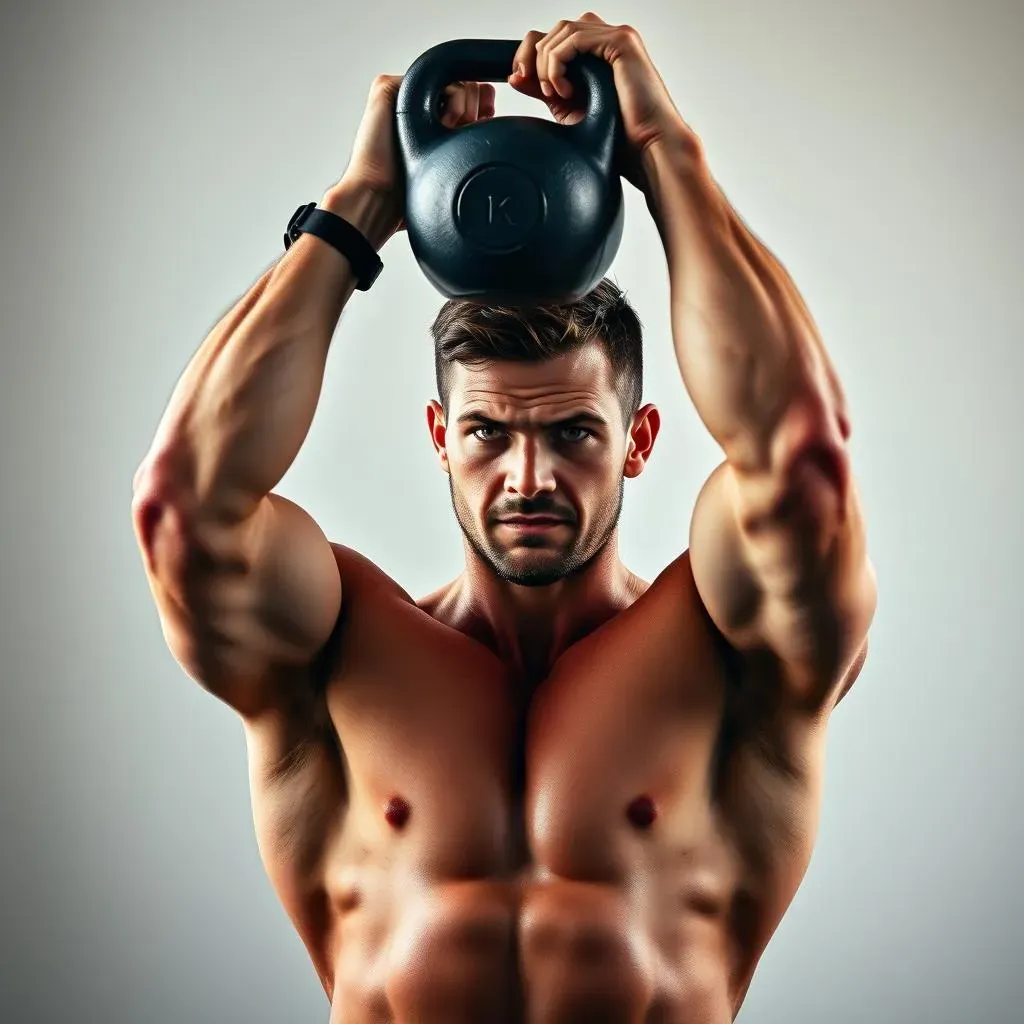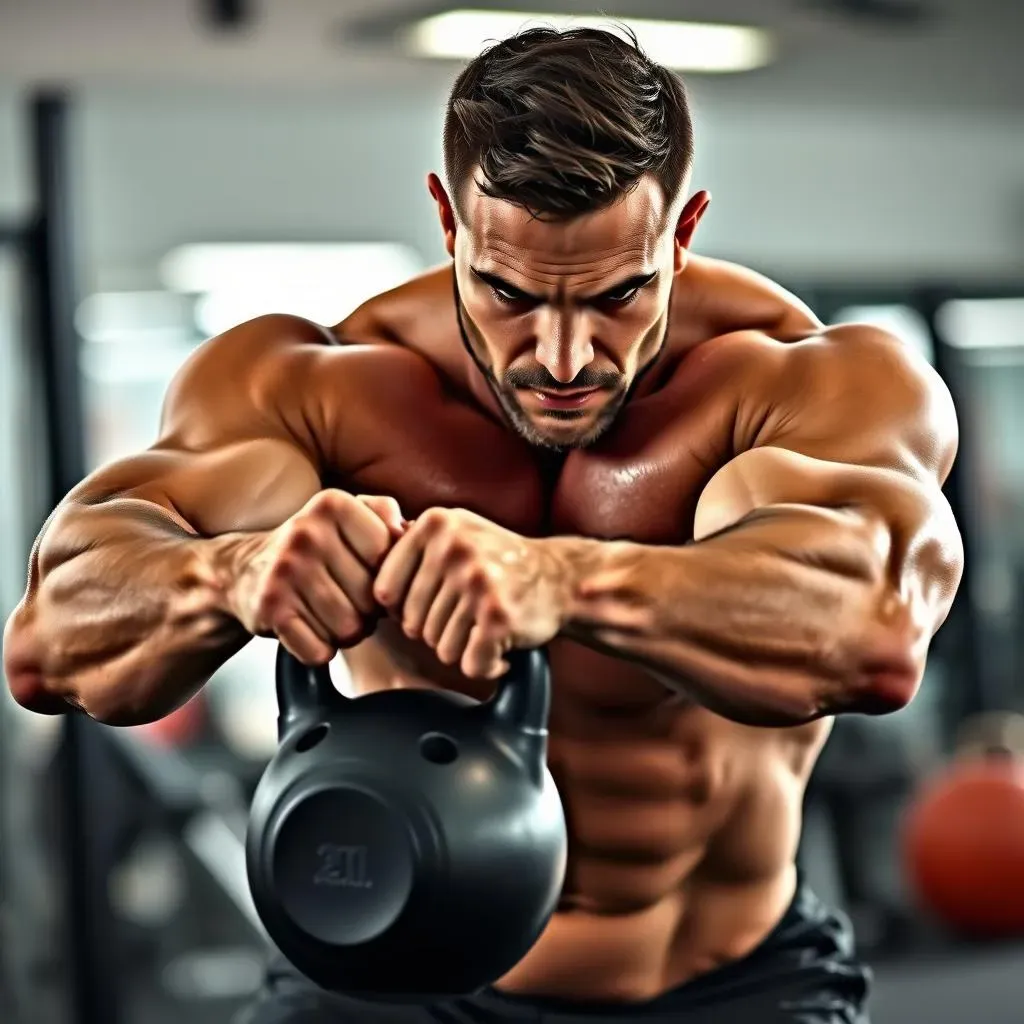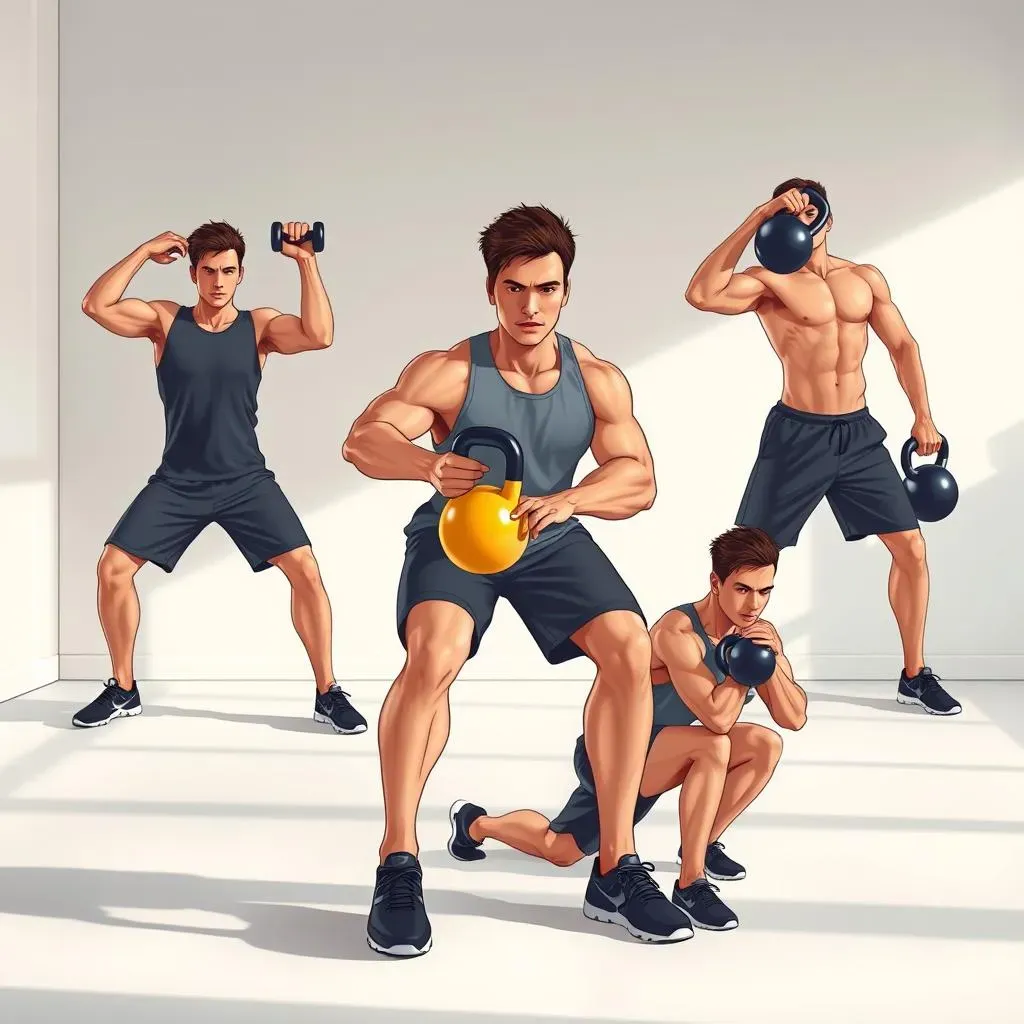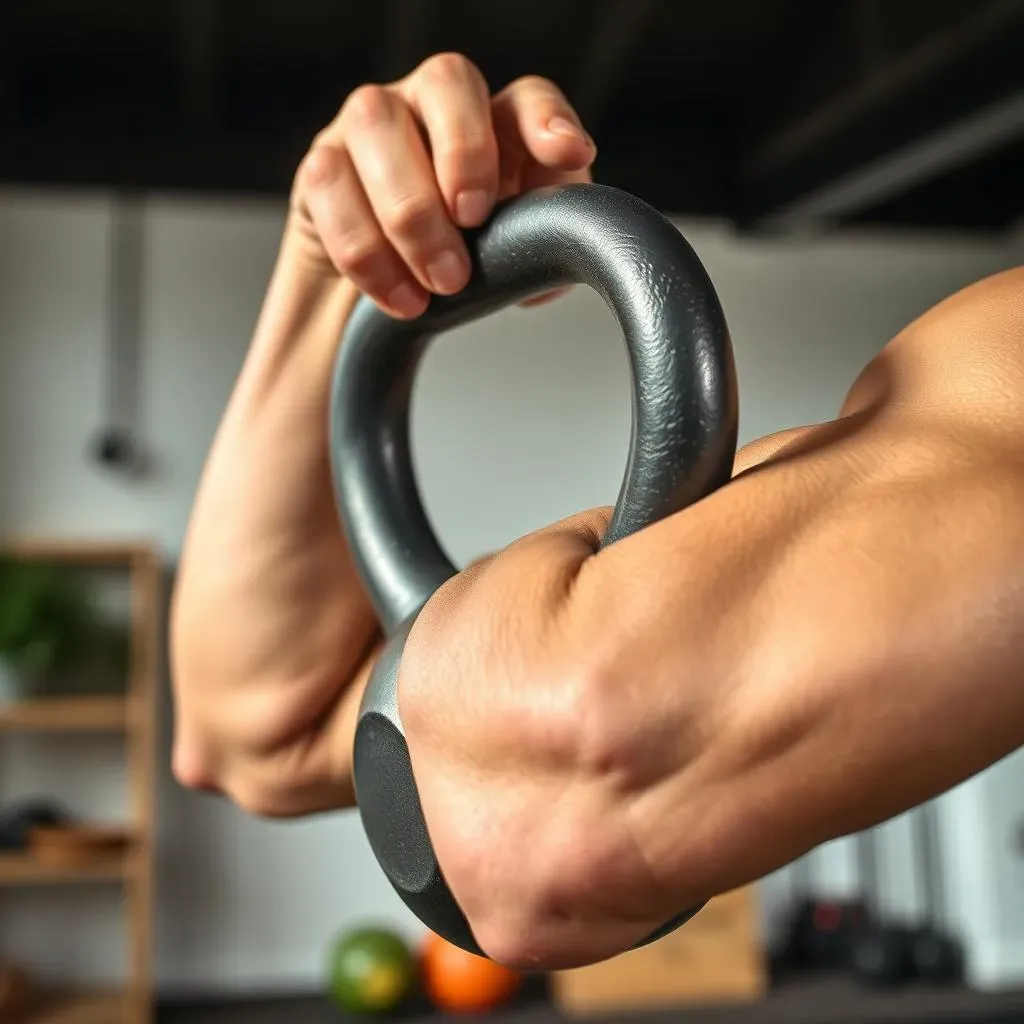Table of Contents
Ever looked at someone with toned arms and wondered how they did it? Forget endless bicep curls with those tiny dumbbells. Let's talk about kettlebells. They're not just for the gym bros, they're also fantastic for a kettlebell arm workout for beginners like you. Kettlebells can help you build real-world strength and sculpted arms. This isn't about isolating one muscle at a time. Instead, we are going to work movement patterns that engage your whole body. In this article, we're going to explore the best kettlebell exercises for your triceps and biceps. I will show you some killer combination moves that will turn your arms into powerhouses. We will go through how to put it all together into a solid workout routine, and answer some frequently asked questions. So grab your kettlebell, or maybe just a water bottle for now, and let's get started.
Kettlebell Exercises for Triceps: Building Strength in the Back of Your Arms

Kettlebell Exercises for Triceps: Building Strength in the Back of Your Arms
Alright, let's get into the good stuff, the triceps! These muscles on the back of your arms are often neglected, but they're crucial for pushing movements and overall arm strength. Kettlebells are amazing for tricep work because they force you to stabilize and control the weight through a full range of motion. We aren't going for isolation here. Instead, we're focusing on compound movements that light up your triceps while engaging other supporting muscles. This means more bang for your buck and more functional strength. Think about it, when do you ever just isolate your triceps in real life? Never! We want strength that translates to real-world activities, not just mirror muscles.
So, what are the best kettlebell exercises to build those triceps? Well, we've got a few awesome options. First, the classic overhead press is a killer for triceps when done right. You're not just pushing the weight up, you’re actively squeezing your triceps at the top of the movement. Then there's the push press, a more explosive version that helps develop power. And, don't forget the tall kneeling press; it reduces momentum and forces your triceps to do more of the work. You may ask, why not just do triceps extensions? Well, kettlebells aren’t really made for that. They are made for movement patterns that engage your whole body.
Exercise | Why it Works | Tips |
|---|---|---|
Overhead Press | Works the entire triceps muscle group. | Keep your core tight, press straight up, and squeeze at the top. |
Push Press | Engages the triceps with more power and explosiveness. | Use a slight dip and drive with your legs for added force. |
Tall Kneeling Press | Isolates the triceps by removing lower body momentum. | Maintain an upright posture and focus on the triceps. |
Remember, it's not about how much weight you can lift, it's about how well you can control the weight. Start light, get your form down, and then gradually increase the weight as you get stronger. Don’t rush it. Also, don’t forget to breathe! Holding your breath during these exercises is a one-way ticket to a headache and a bad workout. So, inhale before you press, and exhale as you push. Simple as that. Keep your body tight, and your mind focused on the movement. Your triceps will thank you, I promise.
Kettlebell Exercises for Biceps: Sculpting the Front of Your Arms

Kettlebell Exercises for Biceps: Sculpting the Front of Your Arms
Biceps Aren't Just for Show
Okay, now let’s get to the biceps, the muscles everyone loves to show off. But, they're not just for looking good in a t-shirt, they’re essential for pulling movements and arm strength. With kettlebells, we're not just doing basic curls. Instead, we're using moves that work your biceps while engaging your core and back, making it a full-body workout. Forget those isolation exercises, we are going for functional strength, strength that will help you lift groceries, carry your kids, and even open that pesky pickle jar. Kettlebells help you build strength that actually matters.
So, what are the best moves for your biceps? Well, we have a few great exercises that go beyond the classic bicep curl. The goblet squat, surprisingly, is a great bicep builder. You hold the kettlebell close to your chest, which activates your biceps as you squat. Then, we’ve got the regular row and the suitcase row. These are fantastic for working your back, but your biceps kick in big time to help pull the weight. Finally, let's not forget the plank row, it engages not just your biceps but your whole core, making it a super effective exercise.
Exercise | Why it Works | Tips |
|---|---|---|
Goblet Squat | Engages the biceps while working your legs and core. | Keep the kettlebell close to your chest, squat deep, and keep your back straight. |
Regular Row | Works the biceps and back muscles together. | Pull the kettlebell towards your hip, keep your elbow close to your body. |
Suitcase Row | Works the biceps, back and core unilaterally. | Pull the kettlebell towards your hip, keep your core tight, do not twist your body. |
Plank Row | Engages your biceps, core and back. | Keep your body stable in a plank position, pull the kettlebell towards your hip. |
Form is King
Now, just like with triceps, form is absolutely crucial here. It’s not about swinging the kettlebell around like a wild west cowboy. It's about controlled movements that engage the right muscles. Start with a weight that you can manage with good form. It might feel light at first, but trust me, your biceps will be burning soon enough. Also, think about squeezing your biceps at the top of each movement. It's like giving your biceps a little extra hug. This helps to maximize the muscle activation and get the best results. Don’t forget to breathe either, keep it smooth and steady.
Remember, building great biceps isn't just about lifting weights; it's about lifting them correctly. So, focus on your form, control the weight, and squeeze those muscles. You will be surprised how quickly you will see results. Don’t be afraid to watch some videos, or ask a coach for help. We are working towards strength and health, and that is what matters.
Kettlebell Combination Exercises for Arms: Full Body Engagement

Kettlebell Combination Exercises for Arms: Full Body Engagement
Alright, let’s move into the really fun stuff: combination exercises. These aren’t your typical bicep curls or tricep extensions. Instead, these moves combine multiple exercises into one fluid motion, engaging your arms while working other major muscle groups. Think of it like a dance, but instead of dancing, you’re building muscle, burning calories, and getting a killer workout. These combination exercises are fantastic because they save you time and challenge your body in a new way. It’s not about isolating one muscle at a time, it’s about making your body work as one unit. This is where kettlebells truly shine, forcing your body to stabilize and control the weight as you transition between movements. It’s like a symphony of strength, and your body is the orchestra.
So, what are some awesome combination moves? Well, we have the clean and press, a full body movement that will work your arms and legs. Then we have the squat and press, which combines the lower body power of the squat with the upper body strength of the press. And, last but not least, we have the lunge and press, which is an amazing way to challenge your balance and coordination. These moves aren't just about building arm strength; they’re about building a stronger, more resilient body overall. They engage your core, legs, and back, making them super efficient and effective for anyone looking to maximize their workout.
Exercise | Why it Works | Tips |
|---|---|---|
Clean and Press | Full-body exercise, works arms, legs, and core. | Use a smooth, controlled movement, and keep the kettlebell close to your body. |
Squat and Press | Combines lower body strength with upper body power. | Squat deep and press the kettlebell overhead in one fluid motion. |
Lunge and Press | Challenges balance and coordination while building strength. | Step into a lunge and press the kettlebell overhead at the same time. |
Remember, with these combination exercises, it’s all about smooth transitions and controlled movements. Don’t rush through them, focus on your form, and make sure you're engaging the right muscles. Start with a lighter weight, and gradually increase it as you get stronger. Also, pay attention to your breathing. Inhale as you go down, exhale as you press up. It’s a simple thing, but it makes a big difference. These combination exercises are a game-changer, and will definitely take your arm workout to the next level.
Crafting Your Kettlebell Arm Workout: A Beginner's Guide

Crafting Your Kettlebell Arm Workout: A Beginner's Guide
Putting It All Together
So, you've got a bunch of great kettlebell exercises for your arms, but how do you actually put them together into a workout? Well, it’s simpler than you might think. You don't need a fancy gym membership or a personal trainer to get started. The key is to choose a few exercises from each category we’ve talked about: triceps, biceps, and combination moves. Then, you're going to create a circuit. A circuit is just a series of exercises you do one after the other with minimal rest in between. It's like a dance, where each move flows into the next.
For example, you could start with the overhead press for triceps, followed by the goblet squat for biceps, and then finish with the clean and press for a full body blast. The number of repetitions and sets you do depends on your fitness level. If you’re a beginner, start with 2-3 sets of 8-12 repetitions for each exercise. As you get stronger, you can increase the number of sets and reps, or even add more challenging variations of the exercises. The most important thing is to listen to your body and make sure you're using proper form. Don't rush into it. It's a marathon, not a sprint.
Sample Workout Plan
Let's break down a sample workout plan. Think of this as a template, feel free to adjust it to your own fitness level. We are going to start with a warm-up. Something like arm circles, leg swings, and some light cardio for 5-10 minutes. Then, we move into the actual exercises. We will begin with 3 sets of 10 repetitions of overhead press, followed by 3 sets of 10 repetitions of goblet squat, and then 3 sets of 8 repetitions of clean and press. After the circuit, take a 1-2 minutes rest, and repeat this circuit 2 to 3 times. Don't forget to cool down with some light stretching afterwards. This is a good way to finish your workout and help your body recover.
Exercise | Sets | Reps |
|---|---|---|
Overhead Press | 3 | 10 |
Goblet Squat | 3 | 10 |
Clean and Press | 3 | 8 |
Choosing the Right Kettlebell
One of the most common questions I get is about what size of kettlebell to use. It’s a good question, but there's no one-size-fits-all answer. It really depends on your current strength level and your fitness goals. For most women, a good starting point for a kettlebell arm workout is an 8kg to 12kg (18lb to 26lb) kettlebell. For men, a 12kg to 16kg (26lb to 35lb) is a good place to start. However, it's important to remember that these are just guidelines. If you're a total beginner, you might want to start with an even lighter kettlebell, maybe even a 4kg or 6kg (10lb or 13lb). The most important thing is to choose a weight that allows you to maintain proper form throughout the entire exercise. It's better to start too light than too heavy.
If you're not sure what weight to start with, I recommend trying out a few different kettlebells at your local gym, or even just using a water bottle or a bag of rice at home. See how they feel when you try the exercises. Remember, you can always increase the weight as you get stronger. The key is consistency. The more you train, the stronger you will get and the heavier the kettlebell you will be able to lift. So, start where you are, and let your progress do the rest.
Kettlebell Arm Workout: Common Questions

Kettlebell Arm Workout: Common Questions
Is Kettlebell Training Effective for Arm Strength?
Okay, let's address the elephant in the room: is kettlebell training actually effective for building arm strength? Absolutely! I know, you might be thinking, "But I've seen those bodybuilders with massive arms lifting dumbbells." Here's the thing, kettlebells are not about isolating one muscle at a time. Instead, they work your entire body, including your arms, in a more functional way. Think of it like this: you're not just building biceps and triceps, you're building real-world strength that you can use in everyday activities. Kettlebells force your body to stabilize and control the weight, which engages more muscles than just doing a basic bicep curl. You end up with stronger, more resilient arms that are ready for anything.
Also, kettlebell training is a great way to improve your grip strength, which is often overlooked but crucial for overall arm function. The unique shape of the kettlebell forces you to grip it tightly, which builds strength in your forearms, wrists, and hands. This translates to better performance in other exercises and daily tasks. Forget those tiny dumbbells, kettlebells are the real deal when it comes to building functional arm strength.
How Often Should I Do a Kettlebell Arm Workout?
Alright, so you're excited to start, but how often should you actually do a kettlebell arm workout? Well, it's not about working out every single day. Your body needs time to rest and recover. I know, it can be hard to resist wanting to train every day, but trust me, rest is just as important as training. For beginners, I recommend aiming for 2-3 kettlebell workouts per week, with at least one day of rest in between. This allows your muscles to repair and rebuild, which is where the magic happens. If you're more advanced, you might be able to handle 3-4 workouts per week, but always listen to your body and take rest days when you need them. Pushing yourself too hard can lead to injuries and burnout, and that is not what we want.
Also, don't forget that your diet and sleep also play a huge role in your recovery. Make sure you're eating enough protein to support muscle growth and getting enough sleep each night. It's like building a house, you need the right materials and the right foundation to make it strong. So, be consistent with your workouts, but also be consistent with your rest, diet, and sleep. It's all connected.
What if I Don't Have a Kettlebell?
Okay, so you're all fired up to start, but what if you don't have a kettlebell? Don't worry, you don't need a fancy gym membership to get started. There are plenty of things you can use as a substitute. A water bottle, a bag of rice, or even a heavy book can work as a makeshift kettlebell, especially when you're starting out. It's not about having the perfect equipment; it's about making the most of what you have. You can also use resistance bands, and bodyweight exercises to get started. The point is, don't let the lack of equipment stop you from starting.
Also, keep in mind that you can always invest in a kettlebell later on. But for now, focus on learning the movements and getting your form right. It's better to start with something simple and get good at it, than to wait until you have the perfect setup. So, grab whatever you have, and let's get moving. Remember, it's not about the tools, it's about the effort you put in.
Substitute | How to Use |
|---|---|
Water Bottle | Fill it up to your desired weight and use it for goblet squats or rows. |
Bag of Rice | Hold it like a kettlebell for squats, deadlifts, or presses. |
Heavy Book | Hold it close to your chest for squats or use it as a weight for rows. |